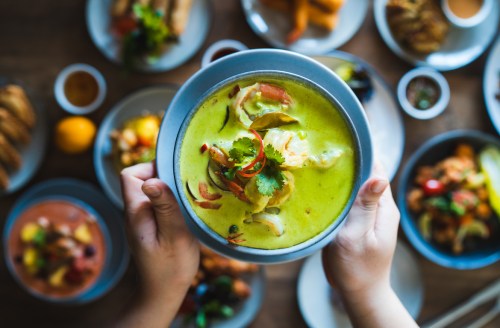6 Foods and Drinks That Can Trigger Rosacea Flare Ups
Here are six common drinks and foods that trigger rosacea flare ups, according to a dermatologist. They include some surprising staples.

Here’s a not-so-rosy reality: More than 16 million Americans live with rosacea, a chronic skin condition characterized by redness and swelling of the nose, cheeks, and forehead. Its symptoms tend to come in waves, with intervals of active flare ups, followed by periods of time where the inflammation recedes. As such, managing rosacea is all about limiting these recurrences by expanding the amount in between—and a big part of that effort has to do with diet.
Experts in This Article
board-certified general and cosmetic dermatologist and clinical instructor at Mount Sinai Hospital
Like other inflammatory conditions, certain foods can make symptoms of rosacea, which include flushing, textural changes to the skin, swelling, broken capillaries, and watery eyes, to become worse. Below, Rachel Maiman, MD, a cosmetic dermatologist who helps her patients tailor their diets to limit skin reactions, breaks down the foods most likely to trigger rosacea flare ups and how best to avoid them.
That’s not to say that you, personally, will have an adverse reaction to everything on this list. “As is almost always the case in medicine, no one patient is the same, and so assessment of one’s triggers is a case-by-case necessity,” says Dr. Maiman. “Just because chocolate triggers a rosacea flare in one patient does not mean that it will trigger flares in another.”
Because what sparks rosacea symptoms is so individualized, Dr. Maiman suggests anyone looking to optimize their diet work in tandem with a dermatologist. “Knowledge of potential triggers is a large component of what a dermatologist learns in their training in order to be capable of managing patients with this condition,” she says. “Thus, we can be very helpful in guiding patients towards making the right dietary choices.”
As a general guideline, an anti-inflammatory diet rich in fresh vegetables and fruits, lean protein, and healthy fats can be helpful for anyone with an inflammatory skin condition, including rosacea.
6 foods that trigger rosacea symptoms
High-acid vegetables
Examples: tomatoes, carrots, hot peppers, beets, eggplants, onions, radishes, and spinach
“The rationale for avoidance of high-acid foods is that basic cellular mechanisms such as detoxification, elimination, and repair fail to function as optimally as they should in the presence of an acidic pH,” Dr. Maiman said.
When these essential mechanisms fail, the skin barrier struggles to repair itself, so inflammation and redness caused by rosacea become more difficult to treat and heal at a slower pace. “Rosacea sufferers may want to stick to neutral vegetables with high water content, like asparagus, cucumbers, sweet potatoes, leafy greens, pumpkins, broccoli, cauliflower, celery, okra, lettuce, green beans, and zucchini,” suggests Dr. Maiman.
Refined/concentrated sugars
Examples: soda, candy, commercial fruit juices, sugary breakfast cereals, and snack foods like chips, cookies, and crackers
This Parisian Skincare Brand Is Launching in the United States for the First Time—Here’s What a Derm Wants You to Know

We’re Calling It: Cleansing Balms Are the Face Wash of the Future—Here Are 3 to Add to Your Cart

This Is the One Product That Scarlett Johansson Always Keeps in Her Purse and on Her Bedside Table

If you’ve been around the high-fructose corn syrup block, you know what we’re talking about here: junk food. “Foods high in refined/concentrated sugars can trigger rosacea because these simple carbohydrates trigger high insulin release, which activates inflammatory hormones, such as prostaglandins.”
Spicy foods
Examples: chili peppers, jalapenos, hot sauces, curry, cayenne pepper, certain salsas, and tabasco pepper
The reason these foods can cause a rosacea flare up is a common ingredient called capsaicin, which is the very substance that gives these foods their characteristic heat. It’s a chemical irritant that messes with the receptors in your skin that recognize and feel warmth, leaving people who have rosacea feeling hot and looking red. “Choice of spices should be done carefully, with more soothing spices like coriander, cardamom, saffron, fennel, and turmeric being favored,” says Dr. Maiman.
Histamine-rich foods
Examples: citrus fruits, chocolate, bananas, nuts, broad-leaf beans, and pods (like lima or navy beans and peas), avocados, and shellfish
Histamine is involved in local immune responses, like inflammation, and can cause your red blood vessels to dilate, “thus increasing blood flow and, by extension, redness,” Dr. Maiman explains. When blood vessel dilation occurs frequently, it can progress into a state of permanent dilation, producing the visible vessels (known as telangiectasias) that are characteristic of rosacea.
Dairy
Examples: primarily products that contain trans fatty acids, like yogurt, sour cream, and cheese (except cottage cheese)
Dairy, as you may be expecting at this point, is also an inflammatory food group that promotes redness and swelling. Luckily, we are living in the golden age of dairy substitutes, where there’s no shortage of non-dairy options to satisfy that milk, cheese, or yogurt craving.
Alcohol
Examples: especially red wine, beer, bourbon, gin, vodka, or champagne
Another blood vessel-dilating, inflammation-promoting situation here. Red wine, in particular, contains a chemical called tyramines—a histamine-like compound that dilates vessels even more.
If, rosacea-be-damned, you still want to enjoy brunch or happy hour, you can limit the effects of alcohol by alternating your cocktail with sips of water. You can also keep track of what kinds of alcohol are better or worse for your rosacea and steer clear of your unique triggers when imbibing.
Oh hi! You look like someone who loves free workouts, discounts for cult-fave wellness brands, and exclusive Well+Good content. Sign up for Well+, our online community of wellness insiders, and unlock your rewards instantly.
Sign Up for Our Daily Newsletter
Get all the latest in wellness, trends, food, fitness, beauty, and more delivered right to your inbox.
Got it, you've been added to our email list.







